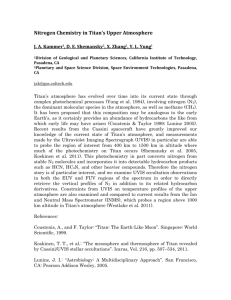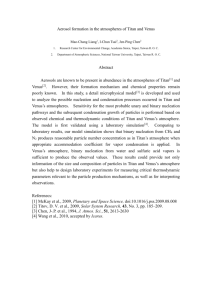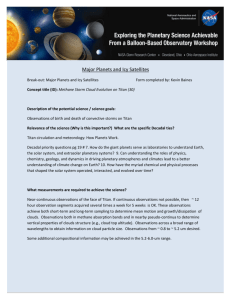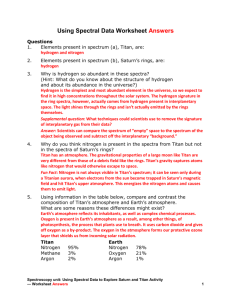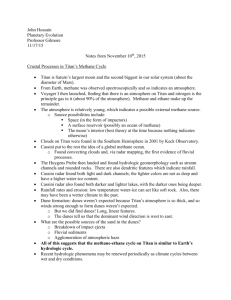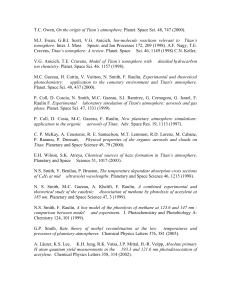DOC - Lunar and Planetary Institute
advertisement
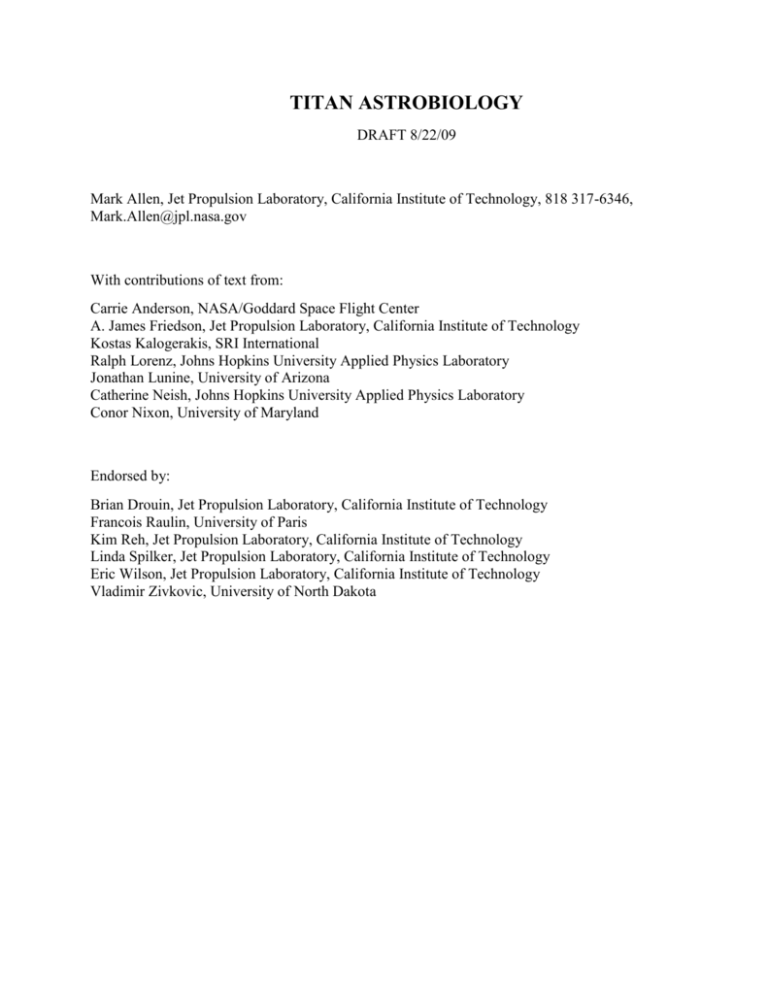
TITAN ASTROBIOLOGY DRAFT 8/22/09 Mark Allen, Jet Propulsion Laboratory, California Institute of Technology, 818 317-6346, Mark.Allen@jpl.nasa.gov With contributions of text from: Carrie Anderson, NASA/Goddard Space Flight Center A. James Friedson, Jet Propulsion Laboratory, California Institute of Technology Kostas Kalogerakis, SRI International Ralph Lorenz, Johns Hopkins University Applied Physics Laboratory Jonathan Lunine, University of Arizona Catherine Neish, Johns Hopkins University Applied Physics Laboratory Conor Nixon, University of Maryland Endorsed by: Brian Drouin, Jet Propulsion Laboratory, California Institute of Technology Francois Raulin, University of Paris Kim Reh, Jet Propulsion Laboratory, California Institute of Technology Linda Spilker, Jet Propulsion Laboratory, California Institute of Technology Eric Wilson, Jet Propulsion Laboratory, California Institute of Technology Vladimir Zivkovic, University of North Dakota Titan, the haze-enshrouded moon of Saturn, has the largest accessible inventory of organic molecules in the Solar System outside of the Earth. With intimate contact between complex organic compounds raining out of the atmosphere and water (in the Titan context, typically frozen rock, but under some circumstances in liquid form), the prospects are high for the formation of prebiotic compounds not unlike what might have preceded the origin of life in the early history of the Earth. Any evidence of this early chemistry has long been erased from the Earth, but on Titan these chemical processes occur in the present day, and can be directly sampled on a future landed mission. BACKGROUND A key characteristic of Titan is its massive inventory of organic chemicals. The first step in the path toward understanding the role of organics in Titan’s atmosphere was the discovery of methane (CH4) by Kuiper in 1944. Subsequent polarization measurements by Veverka and separately Zellner, both in 1973, indicated the presence of a solid phase component in the atmosphere. These observations were the impetus for the laboratory experiments of Khare and Sagan (1973), which first suggested that methane photolysis could result in solid organic aerosols that Sagan referred to as “tholins” (Sagan and Khare 1979). When Voyager 1 flew past Titan in the early 1980s, it discovered nitrogen to be the primary atmospheric constituent and verified the presence of methane. It detected a host of more complex hydrocarbons and nitriles in trace abundances, only a handful of which had been seen from Earth, which resulted from the photolysis and energetic particle bombardment of the atmosphere. It measured the properties of the thick organic haze that both scattered and absorbed visible and infrared photons, thereby playing an important role in determining the satellite’s thermal structure. The laboratory studies carried out on the basis of the Voyager observations subsequently produced organic aerosols that were a good model for the Titan haze. Based on this model, it was possible to conclude that the haze on Titan is composed of refractory organics that, once condensed, do not evaporate and are ultimately deposited on the surface with a net production rate of ~10-14 g cm-2 s-1 (McKay et al. 2001). Voyager demonstrated that very little oxygen exists in the atmosphere, mainly in the form of CO, with subsequent Earth-based studies providing evidence for water-ice and possibly carbon dioxide on the surface (Lellouch et al. 2003; Griffith et al. 1991; Coustenis et al. 1995). Post-Voyager, several decades elapsed with little new data available regarding Titan’s atmospheric chemistry. Exceptions to this were two important detections by the Infrared Space Observatory: water (Coustenis 1998) and benzene (Coustenis 2003), the first aromatic molecule to be discovered to date. Nevertheless, there was substantial progress in photochemical and microphysical modeling during this period prior to Cassini (e.g. Wilson and Atreya 2004; Rannou et al. 2004). The Cassini-Huygens era of investigation has furthered our understanding of Titan as the largest abiotic organic factory in the solar system. The abundance of methane and its organic products in the atmosphere, seas and dunes exceeds by more than an order of magnitude the carbon inventory in the Earth’s ocean, biosphere and fossil fuel reservoirs (Lorenz et al. 2008). Mass spectrometry in the upper atmosphere has shown that the process of aerosol formation appears to start more than 1000 km above the surface through a complex interplay of ion and neutral chemistry initiated by energetic photon and particle bombardment of the atmosphere 1 (Waite et al. 2007), and includes polymers of high molecular weight—up to and certainly beyond C7 hydrocarbons that the Cassini mass spectrometer was able to measure. Measurements throughout the atmosphere, both remotely and in situ, have indicated the presence of numerous hydrocarbon and nitrile gases, as well as a complex layering of organic aerosols that persists all the way down to the surface. (Coustenis et al. 2007; Tomasko et al. 2005). The molecular composition of these aerosols has still to be determined. Radar observations indicate expansive organic dunes that produce an equatorial belt around the surface. These dunes may be a manifestation of ongoing aeolian processes or may be the remnant of a past climate. In either case, they provide clues to the nature of near-surface climatic conditions under which astrobiological processes must be able to operate. While the chemical reactions that drive living things take place in liquid water, the reactions themselves are almost entirely between organic (i.e., carbon-bearing) compounds. The study of organic chemistry is an important, and arguably richer, adjunct to the pursuit of liquid water in the solar system. Titan’s organic inventory is, as noted above, nothing short of massive, and organic compounds are widespread across the surface in the form of lakes, seas, dunes, and probably sedimentary deltas at the mouths of channels. In Titan’s present atmosphere, with little oxygen, photochemistry alone is something of an evolutionary dead end, in that only hydrocarbons and nitriles (i.e., H, C, and N-bearing molecules) are formed in any abundance. Little oxygen comes in from space, and most of that ends up in the form of carbon monoxide in the atmosphere. However, some influx of energetic oxygen ions (Hartle et al. 2006a,b) may be incorporated into macropolymeric acetylene compounds, which might lead to the production of oxygenated tholin-like compounds (Sittler et al. 2009). However, as noted by Thompson and Sagan (1992), the larger fraction of oxygen-free tholins deposited on Titan’s surface may be able to take the next evolutionary step by reacting with transient exposures of liquid water, namely impact melt and cryovolcanism. Subsequent work has confirmed that such geological structures would indeed permit aqueous chemistry to occur for centuries or longer (e.g., O’Brien et al. 2005; Neish et al. 2006). Laboratory experiments have shown that the interaction of water with organic aerosols can yield amino acids in substantial amounts— roughly 1% by mass (e.g., Khare et al. 1986; McDonald et al. 1994). Simpler nitriles have been detected in the gas phase on Titan (and indeed in the solid phase [Khanna 2005 and other authors]). These nitriles will be deposited as condensate on the surface and also can react to form astrobiologically interesting material in water. For example, Ferris et al. (1978) show that moderately concentrated HCN solutions can hydrolyze to form oligomers that in turn yield amino acids and pyrimidines. (Purines and pyrimidines— organic rings with some substitution of carbon atoms by nitrogen—form the bases that encode information in DNA in terrestrial living things; this information is used to determine the sequence of amino acids used to assemble into proteins.) The temperature- and pH-dependence of the rates and yields of these reactions have been studied in the laboratory (Neish et al. 2008, Neish et al. 2009). Oxygen incorporation into organic aerosols is remarkably fast, both in pure water and 13 wt. % ammonia-water. The reactions occur over time scales as short as days and weeks even at temperatures as low as 253 K, producing a product that is several percent oxygen by mass. Other factors (e.g., inorganic catalysts, or the pressure and concentration enhancements that can occur at a freezing front) may 2 accelerate these reaction rates. For example, Takenaka et al. (1996) explored how freezing can accelerate, by a factor of 100,000, the oxidation of nitrite by dissolved oxygen to form nitrate. Given the long timescales over which liquid water is available on Titan, there is plenty of time for aqueous prebiotic chemistry to occur there. The extent to which present-day Titan resembles the prebiotic Earth is not clear, since the oxidation state of the early Earth is not well determined. Certainly the present Titan is more oxygen-poor than was Earth, but formation of organic haze may nonetheless have taken place on our own planet early in its history. Trainer et al. (2004) show that organic haze formation under UV illumination takes place as long as the carbon to oxygen ratio is above about 0.6, and methane photolysis on the early Earth would have provided a richer organic feedstock than the delivery of organics from meteorites. In addition to the prebiotic synthesis role, haze on the early Earth may have been significant in the radiative balance (acting as an anti-greenhouse agent) and in particular in providing UV opacity which may have protected nascent biota in the absence of an ozone shield. Thus, while the analogy of Titan to the early Earth is not perfect, it is potentially quite close. Titan-like planets may be common in the universe—indeed planets around the most common stellar type, the cool M dwarfs, at the distance of the Earth from the Sun will be as cold as Titan. Titan may usefully inform us about their organic chemistry and potential habitability. The surface of Titan appears at first glance to be an unlikely location for extant life, at least terrestrial-type life. McKay and Smith (2005) have noted that there are photochemically derived sources of free energy on Titan’s surface which could support life, which would have to be an exotic type of life using liquid hydrocarbons as solvents (Committee on the Origin and Evolution of Life 2007). In a similar vein, Stoker et al. (1990) observed that terrestrial bacteria can in fact derive their energy and carbon needs by ‘eating’ tholins. In this sense, a methane-rich atmosphere may act as a ‘poor-planet’s photosynthesis’, providing a means to capture the free energy from ultraviolet light and make it available for metabolic reactions. Benner et al. (2005) have speculated that a form of life, or at a minimum a kind of organized chemical system, can be sustained in liquid hydrocarbons known to be stable on Titan’s surface; the National Academy of Sciences report “The Limits of Organic Life in Planetary Systems” (2007) emphasized the importance the discovery of such a system would imply. Finally, Fortes (2000) argued that life could have gained a foothold in Titan’s subsurface ocean, and evidence of such organic material could be driven to the surface in cryovolcanic events and preserved in the cold, radiation-free surface environment. FUTURE EXPLORATION Cassini-Huygens will leave us with many questions that will require a future mission to answer. These include whether methane is outgassing from the interior or ice crust today, whether the lakes are fed primarily by rain or underground methane-ethane aquifers (more properly, “alkanofers”), how often heavy methane rains come to the equatorial region, whether Titan’s surface supported vaster seas of methane in the past, and whether complex selforganizing chemical systems have come and gone in the water volcanism, or even exist in exotic form today in the high latitude lakes. The composition of the surface and the geographic distribution of various organic constituents remain poorly known. Key questions remain about the ages of the surface features, specifically whether cryovolcanism and tectonism are actively ongoing or are relics of a more active past. Ammonia, circumstantially suggested to be present by a variety of different kinds of Cassini-Huygens data, has not been seen. The presence of a 3 magnetic field has yet to be established. The chemistry that drives complex ion formation in the upper atmosphere was unforeseen and is poorly understood. A large altitude range in the atmosphere, from 400–900 km in altitude, remains poorly explored after Cassini. Much remains to be understood about seasonal changes of the atmosphere at all levels, and the long-term escape of constituents to space. Specific geological sites such as the floors of impact features and the margins of cryovolcanic flows would of course be of particular interest for the in situ investigations, but data at the scale of Cassini (or even an orbiter) do not permit confident determination of the ease of landing or acquiring desired samples. However, the ample evidence of fluvial and aeolian transport on Titan suggests that sediments everywhere likely contain a component of eroded material from such structures. Therefore, in situ sampling locations that are large in scale and are likely repositories of such sediments is of high priority. Two such promising locations are the equatorial dunes, which are likely a vast repository of organic sediments (Radebaugh et al. 2007) and the two large northern hemisphere seas, which if composed of ethane (Brown et al. 2008) and methane could contain within them analyzable amounts (Raulin 1987; Dubouloz et al. 1989) of dissolved organics from elsewhere on Titan. To optimize the scientific return in future exploration of Titan, laboratory experiments, modeling, and theoretical calculations can provide critical data for planning for and analyzing and interpreting new measurements. In conclusion, prebiotic chemical processes begin in Titan’s upper atmosphere and could be extensively sampled by an orbiting spacecraft alone. However, key astrobiological questions cannot be answered without extending the measurements to Titan’s lower atmosphere and the surface as part of a new exploration of Titan. Titan’s surface may replicate key steps toward the synthesis of prebiotic molecules that may have been present on the early Earth as precursors to life. In situ chemical analysis, both in the atmosphere and on the surface, would enable the assessment of the kinds of chemical species that are present on the surface and of how far such putative reactions have advanced. The rich inventory of complex organic molecules that are known or suspected to be present at the surface makes new astrobiological insights inevitable. While completing the full spectrum of Titan investigations in one mission will require a Flagship mission to do, specific objectives may be attainable under Discovery/New Frontiers classes. Therefore solicitations for competed missions should not exclude proposals for Titan missions. 4 REFERENCES Brown, R. H., L. A. Soderblom, J. M. Soderblom et al. (2008), Nature, 454, 607–610. Committee on the Origin and Evolution of Life, Space Studies Board (2007), The limits of organic life, National Academy Press, Washington, DC. Conley (2008), personal communication Coustenis, A., E. Lellouch, J. P. Maillard, and C. P. McKay (1995), Icarus, 118, 87–104. Coustenis, A., A. Salama, E. Lellouch, Th. Encenaz, G. L. Bjoraker, R. E. Samuelson, Th. De Graauw, H. Feuchtgruber and M. F. Kessler (1998), Astron. & Astrophys., 336, L85-L89. Coustenis, A., A. Salama, B. Schultz, S. Ott, E. Lellouch, Th. Encenaz, D. Gautier and H. Feuchtgruber (2003), Icarus, 161, 383-403. Coustenis, A., R. Achterberg, B. Conrath et al. (2007), Icarus, 189, 35–62. Dubouloz, N., F. Raulin, E. Lellouch, and D. Gautier (1989), Icarus, 82, 81–96. Ferris, J. P. et al. (1978), J. Molecular Evolution, 11, 293–311. Fortes, A. D. (2007), Icarus, 191, 743–748. Griffith, C. A., T. Owen, and R. Wagener (1991), Icarus, 93, 362–378. Hartle, R.E. et al., (2006), Planetary and Space Science, 54, 1211-1224, doi:10.1016/j.pss.2006.05.029. Hartle, R. E., et al., (2006), GRL, doi: 10.1029/2005GL024817R. Israël, G., C. Szopa, F. Raulin et al. (2005), Nature, 438, 796–799. Khanna, R. (2005), Icarus, 178, 165–170. Khare, B. N., C. Sagan, H. Ogino et al. (1986), Icarus, 68(1), 176–184. Khare, B. N., and C. Sagan (1973), Icarus, 20, 311. Kuiper, G. P. (1944), Ap.J., 100, 378. Lellouch, E., A. Coustenis, B. Sebag et al. (2003), Icarus, 62, 125–142. Lorenz, R. D., K. A. Mitchell, R. L. Kirk et al. (2008), Geophysical Research Letters, 35, L02206, doi:10.1029/2007GL032118. Lorenz, R. D., S. Wall, J. Radebaugh et al. (2006), Science, 312, 724–727. McDonald, G. D., W. R. Thompson, M. Heinrich, B. N. Khare, and C. Sagan (1994), Icarus, 108(1), 137–145. McKay, C. P., and H. D. Smith (2005), Icarus, 178(1), 274–276. McKay et al. (2001), Planet. Space Sci., 49, 79–99. Neish, C. D., R. D. Lorenz, and D. P. O’Brien (2006), Int. J. Astrobiol., 5, 57–65. Neish, C.D., Somogyi, A., Imanaka, H., Lunine, J.I., and Smith, M.A. (2008) Astrobiology, 8, 273-287. Neish, C.D., Somogyi, A., Lunine, J.I., and Smith, M.A. (2009) Icarus, 201, 412-421. O’Brien, D. P., R. D. Lorenz, and J. I. Lunine (2005), Icarus, 173(1), 243–253. Radebaugh, J., R. Lorenz, R. Kirk, J. Lunine, E. Stofan, R. Lopes, S. Wall, and the Cassini RADAR Team (2007), Icarus, 192(1), 77–91. Rannou, P., F. Hourdin, C. P. McKay and D. Luz (2004), Icarus, 170, 443-462. Raulin, F. (1987), Adv. Space Res., 7, 71–81. Sagan C., and B. N. Khare (1979), Nature, 277, 102–107. Sittler, E.C. (2009), Planetary and Space Science, in press, 2009. Stoker, C. R., P. J. Boston, R. L. Mancinelli, W. Segal, B. N. Khare, and C. Sagan (1990), Icarus, 85(1), 241–256. Takenaka, N., A. Ueda, T. Daimon, H. Bandow, T. Dohmaru, and Y. Maeda (1996), J. Physical Chem., 100, 13874–13884. 5 Thompson, W. R., and C. Sagan (1992), Symposium on Titan, ESA SP, 338, 167–176. Tomasko, M., B. Archinal, T. Becker et al. (2005), Nature, 438, 765–778. Trainer, M. G., A. A. Pavlov, D. B. Curtis et al. (2004), Astrobiology, 4, 409–419. Waite, J. H. Jr., D. T. Young, T. E. Cravens, A. J. Coates, F. J. Crary, B. Magee, and J. Westlake (2007), Science, 316, 870–875. Wilson, E. H. and S. K. Atreya (2004), J. Geophys. Res., 109, E06002. 6


